Maximize monetization and retention with the top four subscription pricing models for 2023.
How do you set your subscription pricing? You might look at your competitors' pricing structure and set yours similarly. Perhaps you're working out your costs and adding a little margin. You could be relying on your intuition.
All these approaches can work — but all of them leave money on the table. The most profitable pricing strategies put customer value front and center, are driven by data, and match your customers' purchasing and usage habits - and they're certainly not pulled out of thin air.
We'll walk through why subscription is so hard, outline a few common strategies and subscription models for setting your pricing, and explain why value-based pricing should be your only pricing model of choice.
What is subscription pricing?
In the subscription-based pricing model, customers pay regularly for a service or product, most commonly a monthly fee. Subscription pricing is different than pricing for traditional products, as pricing is often based on the subscription length, making longer subscriptions the cheapest option.
What companies get wrong about subscription pricing
The amount you charge for products or services should be taken seriously, yet many businesses do not take the time to consider this properly. Companies spend an average of only ten hours each year on their pricing.
This happens for several reasons, such as pressure to acquire new customers instead of optimizing the value of those they already have, a lack of knowledge on how to price, failure to invest in collecting customer data, and many more.
But even if you spend double that amount of time on your pricing strategy, if you're not also avoiding the following mistakes, you could be charging less than you should.
Basing pricing on instinct or “gut feel” over data
When you're just starting out, you might look to competitors' pricing strategies - or worse; you might just guess - where your subscription plans should start. But as you begin quantifying your ideal customers, you'll understand what they truly value in your product and what they're willing to pay for it.
Data needs to be at the heart of every pricing decision you make. Failing to base your subscription pricing on hard data could lead you to overprice or underprice your product or services.
Updating pricing infrequently
Price points that work well in the early days of your subscription business often end up underpricing your product over time. As your product or service improves over time, you should vary your pricing to track the value you provide. Failing to revisit your pricing regularly can only hurt your bottom line.
The data backs this up: Companies who regularly revisit and update their pricing every six months see nearly double the average revenue per user (ARPU) gain over those who update their pricing only once a year or longer.

Overlooking a core revenue driver
Companies spend countless hours improving their product, tweaking their positioning, and acquiring new customers. Yet most subscription as a service companies spend precious little time thinking about their pricing. We studied over 10,000 blog posts on growth and found that only one in ten blog posts was about pricing.
But while pricing discussions are often overshadowed by acquisition, higher pricing is one of the most important levers for revenue growth. Data from our study of 512 companies shows that monetization has nearly 2x the impact of acquisition efforts and a massive 4x the improvement from time spent acquiring more customers.
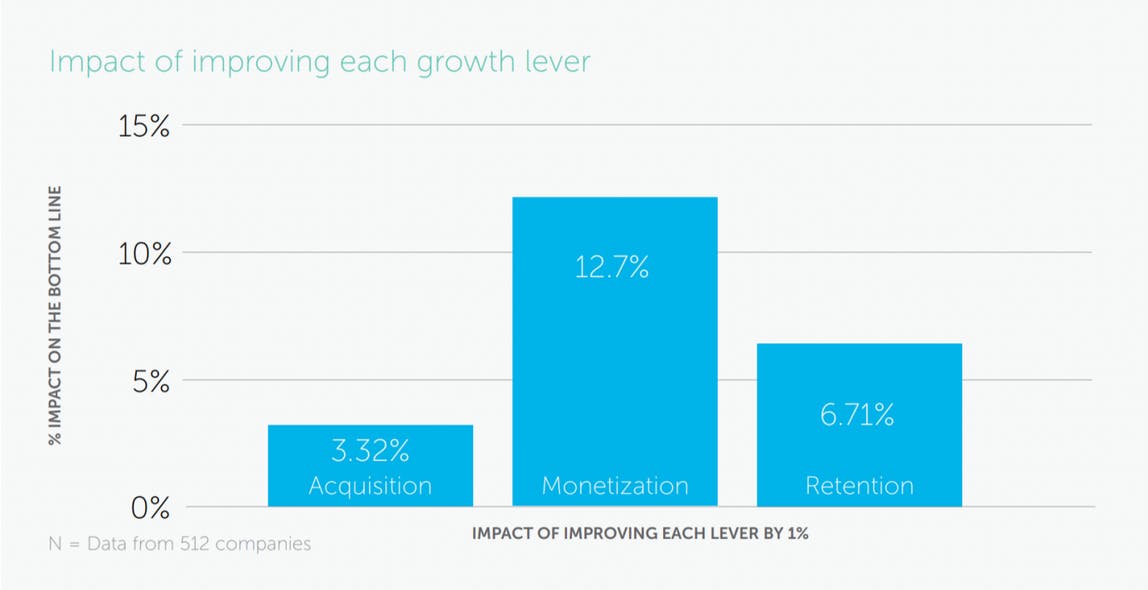
4 types of subscription pricing models
The four common subscription pricing examples for subscription companies are flat rate, tiered, per-user, and usage-based. Each pricing model works best in different situations and scales according to different factors. Choosing the right model can make or break your profit margin.
1. Fixed / flat-rate pricing model
Fixed pricing stays simple: a single product, a fixed set of features, and a fixed monthly price.
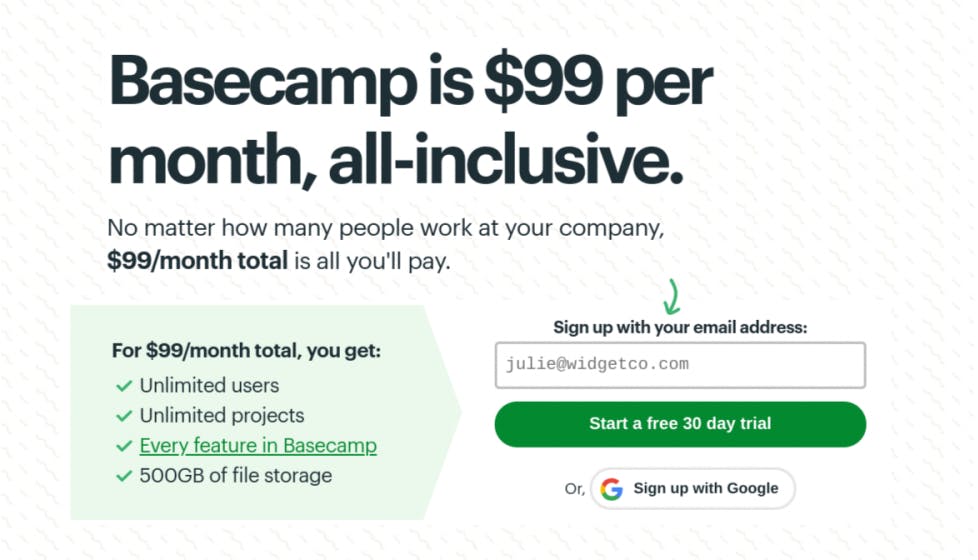
Basecamp offers flat-rate pricing on its project management software.
Flat-rate pricing is easier to communicate and easier to sell; if you're adding valuable features, simply raise your rate. If you add additional products, the fixed price goes on top of your base fixed rate. It's been used by several streaming services and is at the core of the dollar shave club's initial success.
But while flat-rate subscription pricing might be easy for potential customers to understand, it often means leaving money on the table for SaaS companies. Keeping prices low means missing out on additional revenue from larger companies and vice-versa; smaller companies might be priced out of higher-cost tools.
2. Tiered pricing model
Tiered pricing allows companies to offer multiple packages with different features and product combinations available at different price points. The number of packages can vary, but most subscription companies offer two or three pricing tiers.
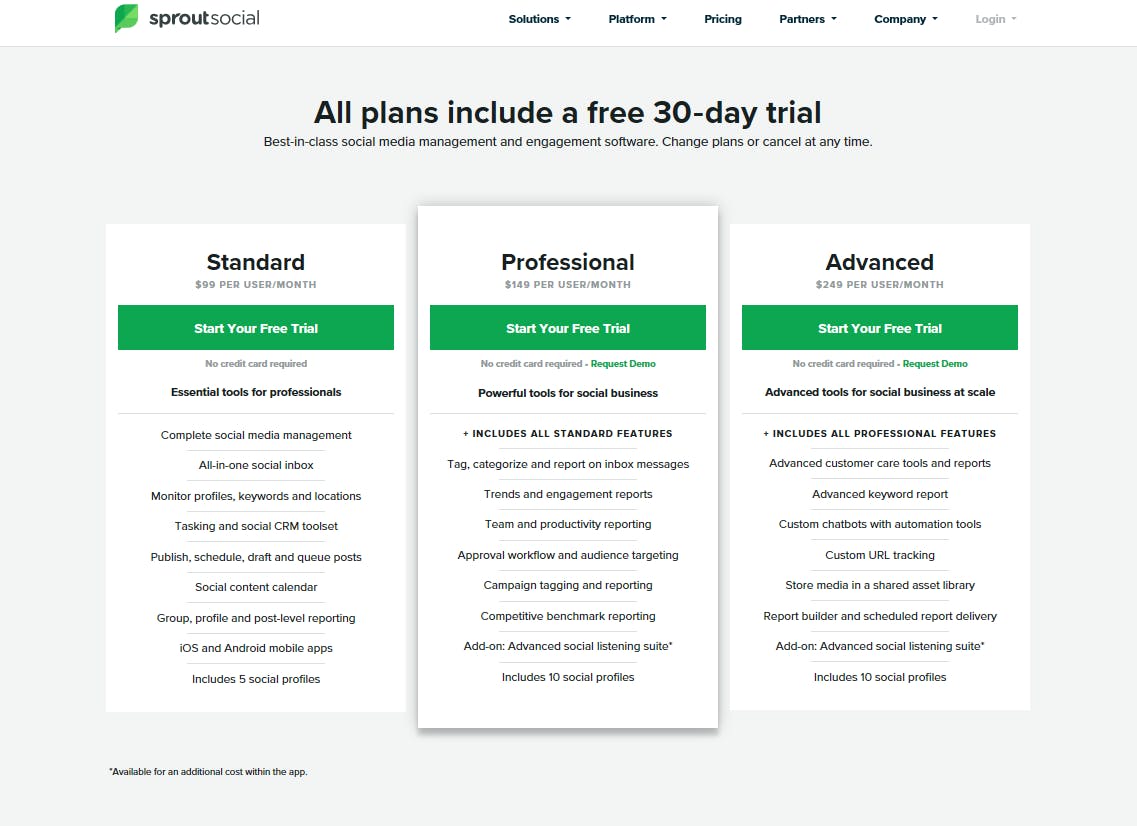
Sprout Social's tiered pricing model offers different combinations of features across their three packages.
Social media management tool Sprout Social designs its tiers around the needs of different customers, whether they're professionals who need "essential tools" or companies looking for advanced tools "at scale." By catering to multiple buyer personas at multiple price points, Sprout Social can maximize how much revenue they can extract from each customer while providing an easy upsell opportunity for long-term users as companies outgrow each tier.
Beyond two or three options, however, things start to go downhill - offering too many choices leads to indecision and lower sales. It's easy to try appealing to customer types with varying budgets by adding more tiers, but this leads to 'analysis paralysis' and lost sales.
3. Per unit/user model
Per-user pricing is the go-to subscription business model for the majority of companies. Pricing scales evenly along with the number of users - the more users, the more you can charge.
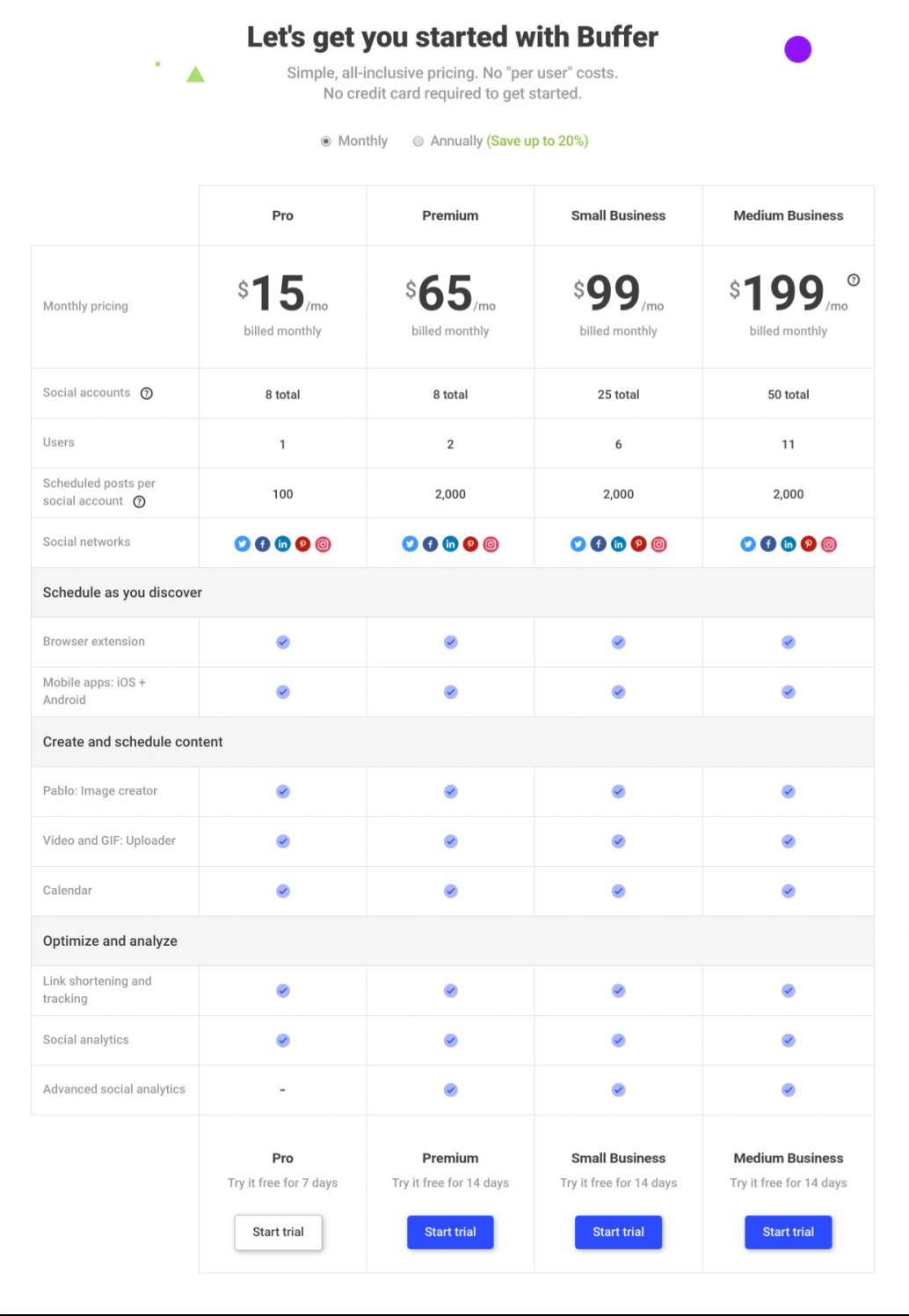
Buffer prices each tier of their social media management tool by the number of users.
Per-user pricing is easy for potential buyers to understand, simplifying the sales process. It also makes forecasting monthly recurring revenue (MRR) straightforward since revenue scales in direct proportion to the number of users.
Charging for each new user does have downsides, though. For example, charging per seat can lead to users sharing logins across teams, cutting into your potential revenue.
4. Usage model
Usage-based pricing is somewhat less common among SaaS businesses - it's mainly used by telecommunications companies and IT services. Users are charged based on how much of a product or service they consume: download 4GB of data in a month, for example, and you'll be charged for exactly 4GB.
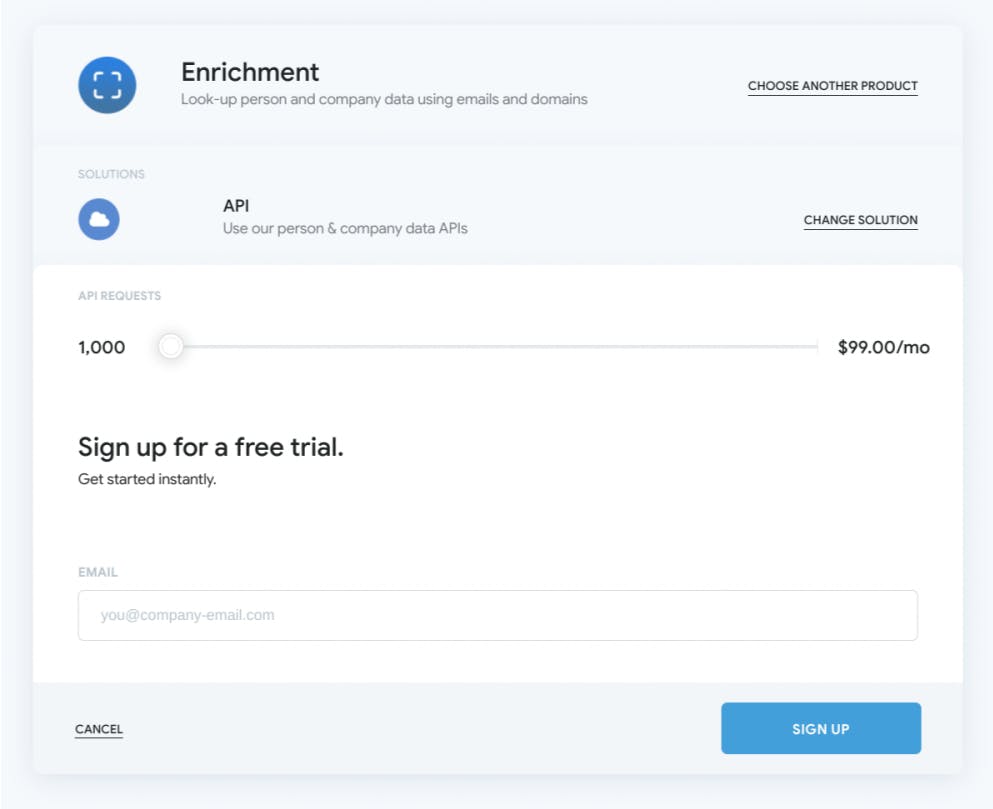
Data enrichment tool Clearbit charges based on the number of API requests each month.
Tying pricing to usage makes it easier for small companies to get started with your product while avoiding the high upfront monthly or yearly fees charged by some subscription companies. On the other end of the scale, it also accounts for additional costs incurred by heavy users, charging them fairly based on the extra time and resources they consume. Charging based on usage does, however, make it much harder to predict revenue since billing can vary dramatically each month.
What to consider when choosing a pricing model
Different situations call for different pricing models. Ask yourself these questions when choosing a pricing model for your recurring revenue business:
What are your fixed and variable costs?
Your subscription pricing needs to account for all your costs - both fixed and variable - of doing business.
First, work out how much it costs you to deliver the base value to the customer. This includes all your operating costs like payroll and benefits, office space, hosting fees, software and tools, merchant fees, and taxes. Next, add in any variable costs, like advertising fees, travel, contract labor, and other miscellaneous services.
These operating costs should be averaged across the total number of customers, giving you an absolute baseline you must charge each customer to break even. Ensure your pricing is high enough to achieve healthy margins, or your business won't be sustainable.
The proportion of fixed versus variable costs should also guide your pricing model decision. For example, if you're charging all customers a fixed price, yet they use resources that fluctuate significantly across different users, you may want to have a usage model for your subscription pricing.
Who are your customers?
Are your customers using your software for business or leisure? Do they prefer paying up-front or spreading payments over time with a monthly subscription? Do they value simplicity or choice when making product decisions? How much are your typical customers willing and able to spend on your product?
Understanding your customer segments helps define which pricing model you choose and how much you charge. Customers who value simplicity might prefer a fixed or tiered pricing scheme over a usage-based one, for example. Match each tier's pricing and feature set to your primary customer segments instead of simply choosing tiers based on which features you want to include.
How does your competition price their products?
This should NEVER be the only pricing strategy you use, but it's important to know. Your customers will benchmark your own pricing model against your competitors, but there's no way of knowing the effectiveness of your competitors' chosen model.
Just as you should be, competitors are constantly updating and tweaking their own pricing models to match their customers' needs and improve customer relationships. Their pricing model might work for your customers, but it's just as likely you'll be leaving money on the table by copying their strategy.
3 popular pricing strategies
Your subscription pricing model provides the framework for how you'll charge customers for your product — but it doesn't cover how much you'll actually be charging. For that, you'll need to define a pricing strategy.
To help you develop your own subscription pricing strategy, let's dive into three common strategies: cost-plus pricing, competitor-based pricing, and value-based pricing.
Cost-plus pricing
This is the most simple approach to setting your prices. Sum up all the fixed and variable costs of doing business, add a percentage margin (around 20%), and set that as the price for your product.
This strategy requires very little market research - assuming you have a handle on your costs, it's easy to determine your price, and you're guaranteed to cover your costs.
Think of pricing like a dartboard, you might be aiming for the bull's eye, but cost-plus pricing still means you're hitting all across the board. Basing your pricing on cost ignores the perceived value of your product and how much customers are willing to pay. Customers don't care about your costs; they care about how much value you can provide.
Particularly for software companies, the unit cost of delivering one account can be extremely low, much lower than the value your customers will get from that account. It's good to understand your costs to help define your absolute lower bound for pricing, but cost-plus pricing is almost never the right strategy.
Competitor-based pricing
Competitor-based pricing involves looking at the prices set by competing businesses in the same sector, raising prices or perhaps discounting a little to account for the value of your product, and then adopting those prices for your own business.
This can be a reasonable approach for companies starting out with a new product or moving into a new industry. You're unsure of the initial value your product provides, and you don't want to completely miss your target, so you look at what everyone else is doing.
It's a simple approach and one that can get you pretty close - but it also means your following their pricing strategy, not yours. You're no doubt offering a better product that provides more value to your customers, but tying your pricing to your competition means you're unable to realize that extra value in your pricing.
You want to know where your competition is pricing their products to know you're in the same ballpark, but don't let their pricing dictate your strategy.
Value-based pricing
Instead of looking inward to your own company costs or laterally toward your competitor's pricing, value-based pricing looks outward towards the people who ultimately decide the right price for your product: your customers.
Value-based pricing strategies utilize customer data on the overall value of your product, as well as breakdowns of the relative value of individual features, to set your pricing. This means getting out of the office, and doing the hard work of asking customers what they'll actually pay for your product. Tying price to value also incentivizes you to provide more value by developing new features and improving your service. Make sure you use a changelog to effectively announce them.
The downside? All this research takes time. You need to be dedicated to finding out more about your customers and your product to properly understand the value you provide. The end result, though, is a price that's much closer to the truth and a price that maximizes your chances of profitability and sustainability.
Additional Strategies
Even after you've chosen a subscription pricing model and a strategy for setting your prices, there's still room to enhance your pricing. Strategies like freemium, upselling and cross-selling, and tiered packages can all squeeze a little bit more from your pricing.
Use these quick tips to help optimize your pricing and maximize your profits.
1. Go freemium.
Freemium tiers and free trials both give potential buyers a chance to try your product before they buy. But keep in mind the freemium model is a customer acquisition model, not a revenue methodology.
We've been saying this for the better part of a decade because too many people think freemium will somehow unlock their pricing when in reality, it's an extremely difficult path to prime leads. And a free trial just won't even come close to its effectiveness when done right.
2. Give users multiple tiers.
We covered this a little earlier, but it's worth repeating here. Giving users multiple options when signing up for your product might sound basic, but many companies only offer two tiers: cheap and useless or expensive and overpowered, neither of which is remotely valuable to buyers.
If you're using a tiered pricing model, make sure your offerings match your users' needs, not your own.
3. If your resources are being drained, try a usage model.
It's nearly impossible to predict how many resources each customer will use in any given month. If you discover your resource demands frequently exceed your expectations, try charging based on usage instead of fixing your pricing. Giving customers the ability to pay only for what they use can help you recover costs easier than increasing pricing across the board.
4. Upsell and cross-sell when needed.
Giving customers the ability to upgrade their accounts as they grow can help grow your customer lifetime value. Look for add-ons that either increase revenue or retention (or both!) and satisfy the upgrade needs of at least 30% of your customer base.
Upselling doesn't have to be automated. If your customers seem to be hitting a wall in their basic plan, send them a personal email or chat to show them your premium offerings may hold up better.
5. Always choose value-based pricing.
Value-based pricing is the gold standard of pricing. If you're still setting your pricing based on your competitors or your costs, your product will be completely off-value from where it needs to be.
Subscription Pricing Summary
Almost every recurring revenue business can benefit from pricing around value. By finding out what's important to your customers, aligning that to value metrics, and building your pricing around those metrics, you can maximize monetization and retention while creating better and more competitive products for your customers.
Remember, value-based pricing takes dedication and time— but we're here to help. Paddle gives you all the subscription metrics you need to increase your revenue.



